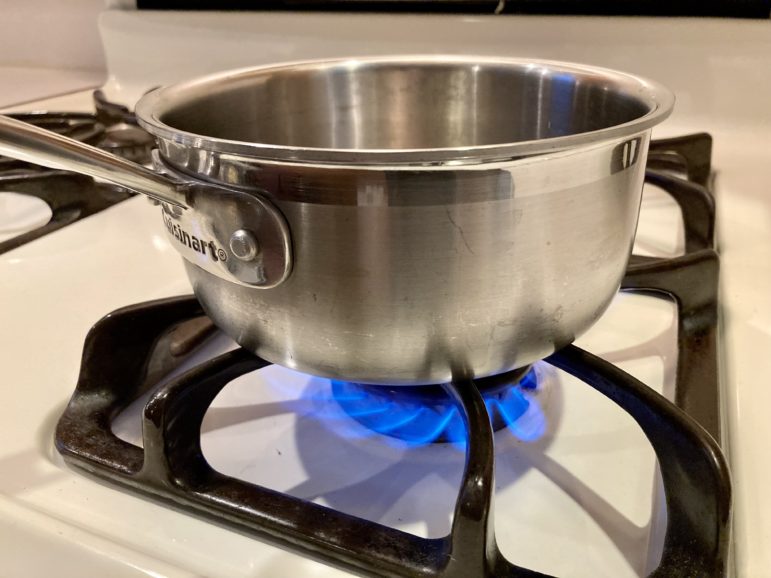An RMI study says that 84 percent of low-income residences in New York rely on piped natural gas, propane or fuel oil for heat, compared to the nationwide average of 54 percent. Burning fossil fuels in homes has been linked to negative health effects, like asthma.

Jeanmarie Evelly
Children who live in homes with gas stoves are more likely to develop asthma than children who live with electric stoves.Low-income households in New York still rely heavily on fossil fuels, a trend linked to adverse health outcomes, a new study finds.
The report published this month examined data around heating in low-income housing. It found that in New York, 84 percent of those residences relied on piped natural gas, propane or fuel oil. That represents the highest percentage of the four states studied, which also included California, Massachusetts and Colorado, and is well over the national average of 54 percent of low-income households that use fossil fuels for heating.
The report was prepared by RMI, a nonprofit group that promotes clean energy, which noted multiple long- and short-term health effects from burning fossil fuels in homes. For instance, children who live in homes with gas stoves are 42 percent more likely to develop asthma than children who live with electric stoves.
It also showed that burning fuels in buildings negatively impacts neighborhood air quality—an issue made worse in environmental justice areas, where pollution from highways, peaker plants and waste transfer facilities already wreaks havoc.
Another study this year by Harvard T. H. Chan School of Public Health—and later visualized by RMI—found that in 2017 (the year with the most recent available data) 1,940 New Yorkers died prematurely due to particulate matter that can be linked to burning fossil fuels in buildings. That represents the highest number of deaths of all 50 states and is linked to more than $21 billion in health costs. The majority, or 75 percent of those deaths and health costs, were directly related to residential, not commercial, buildings.
New York has sought in recent years to reduce its reliance on fossil fuels for cooking and heating. During his State of the City address earlier this year, Mayor Bill de Blasio announced he would seek to ban gas hookups in new construction by 2030.
Two years earlier in 2019, the City Council passed Local Law 97, which set ambitious benchmarks for reducing building emissions, including requiring New York City Housing Authority (NYCHA) buildings—affordable units available to low-income residents—to reduce greenhouse gas emissions from 2005 levels by 80 percent by 2050.
READ MORE: Climate Control is a Year-Round Issue at NYCHA, Especially for Seniors
“New York State is committed to advancing building decarbonization and reducing reliance on fossil fuels in an environmentally sustainable and affordable manner,” said a spokesperson at the New York State Energy Research and Development Authority. She added that the agency plans to partner with NYCHA and invest in improving energy efficiency in its buildings.
Last month, NYCHA released a sustainability agenda which set goals and outlined plans to achieve that reduction. Those include electrifying buildings, installing up to 30 megawatts of solar power and bringing electric vehicle chargers to environmental justice communities.
“NYCHA is committed to reducing its greenhouse gas emissions,” said a spokesperson for the agency. NYCHA will be using $370 million in federal, state and city funding to convert steam heating and hot water to more efficient systems, according to its sustainability plan. “Those systems account for the majority of NYCHA’s greenhouse gas emissions,” the spokesperson said.
Additionally, NYCHA has a five-year plan to install high-efficiency water fixtures, update the buildings’ recycling units and initiate a compost collection program. An interactive map shows specific decarbonization efforts for NYCHA-operated buildings around the city.
The RMI report expressed optimism over heat pump technology, a cost-effective method to both heat and cool buildings that can reduce carbon emissions in a residence by 25 percent. These devices work by transferring outdoor air to heat or cool a home—depending on the time of year—with less reliance on electricity or fossil fuels, according to the U.S. Department of Energy.
Last year, NYCHA completed a pilot heat pump system at a building in the Fort Independence Houses in The Bronx as a way to test the feasibility of the technology.
Liz Donovan is a Report for America corps member.









